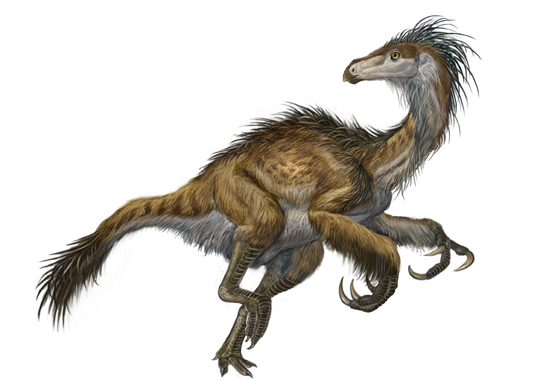| Location: Home > News > Events |
| Discovery Channel: Earliest Feathers for Show, Not Flight |
|
Jennifer Viegas, Discovery News
Jan. 12, 2009 -- The world`s first feathers probably had nothing to do with flight or staying warm but were instead for showy display purposes, according to a new study that documents the most primitive known version of feathers, which were found on a Chinese dinosaur. The dinosaur, Beipiaosaurus, sported the likely colorful feathers on its limbs, trunk, tail, head and neck, with the neck feathers resembling a lion`s mane. Paleontologists now believe feathers evolved very early in archosaurs, the group that included dinosaurs, pterosaurs and relatives of crocodiles, in addition to today`s modern birds, crocodiles and alligators. "Our analysis suggests that feathers might have a much longer history than previously thought," lead author Xing Xu told Discovery News. "The first feathers might have appeared in the fossil record in the Middle Triassic about 235 million years ago," said Xu, a paleontologist at the Chinese Academy of Sciences in Beijing. Xu and colleagues Xiaoting Zheng and Hailu You studied the remains of the Chinese dinosaur, which was excavated at the Early Cretaceous Yixian Formation of Jianchang, western Liaoning. They noticed two types of feathers on the specimen: short, thread-like structures, and longer, stiff, broader ones that represent the rudimentary feathers, according to the study. Both types are described in a paper published in this week`s Proceedings of the National Academy of Sciences. Similar structures have been found on Psittacosaurus, or "Parrot Lizard," as well as some pterosaurs. The researchers therefore suspect the common ancestor of these creatures -- along with Beipiaosaurus, which lived 125 million years ago -- had the early feathers too. Previously documented feathers on dinosaurs were described as having multiple filaments, or many fluff-creating strands. The feathers on the recently documented Chinese dinosaur, however, are believed to represent a much more primitive stage, since the feathers consist of just a single broad filament, but have a different structure than hair. The morphology and distribution of these early feathers rule out use for flight and helping to keep the dinosaur warm, but instead suggest they were flashed during displays, perhaps for mating, identification and competition purposes. "Most previous studies suggest that insulation might have been the primary function for the first feathers, but our discovery supports that display represents one of the earliest functions for feathers," Xu said, adding that "flight function appears very late in feather evolution." The discovery negates the prior theory that feathers and flight co-evolved. It instead indicates pterosaurs, birds and other fliers recruited already existing feathers for flight. Xu and her colleagues aren`t certain how feathers came into being in the first place, but they suspect that at some point, an animal`s skin developed epidermal tissue that gave rise to the thin, tubular protrusions. Members of the opposite sex must have liked what they saw in displays, since the trait stuck and flourished. An average bird today has over 20,000 feathers. Cheng-Ming Chuong and his team from the Keck School of Medicine at the University of Southern California foreshadowed the recent discovery. Their studies on chickens predicted what these first, more basic, feathers would`ve looked like. "Just like Rome, feathers are not made in one process," Chuong said, hinting that a long and colorful history for feathers would likely emerge as more findings, such as the new discovery on Beipiaosaurus, come to light. He added, "While Darwin`s theory has explained the `why` of evolution, much of the `how` remains to be learned. Evo-Devo (evolution of development) research promises a new level of understanding." The remains of the flashy, primitive-feathered Chinese dinosaur are now housed at the Shandong Tianyu Museum of Nature in China. From http://dsc.discovery.com/news/2009/01/12/dinosaur-feathers.html |
